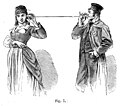 | Micrographia, an acquired disorder, features abnormally small, cramped handwriting. It is commonly associated with neurodegenerative disorders of the basal... 4 KB (402 words) - 07:05, 14 April 2024 |
 | depicted in Micrographia The cell was first discovered by Robert Hooke in 1665, which can be found to be described in his book Micrographia. In this book... 26 KB (3,355 words) - 13:03, 26 April 2024 |
 | the term cell (from Latin cellula, meaning "small room") in his book Micrographia (1665). 1839: Theodor Schwann and Matthias Jakob Schleiden elucidated... 62 KB (6,360 words) - 07:29, 17 April 2024 |
 | Gnat from Robert Hooke's Micrographia, 1665... 7 KB (755 words) - 15:16, 5 April 2024 |
 | An engraving of the cells of cork, from Robert Hooke's Micrographia, 1665... 136 KB (14,353 words) - 10:36, 19 April 2024 |
 | has been understood in general terms since Robert Hooke's 1665 book Micrographia, where Hooke correctly noted that since the iridescence of a peacock's... 19 KB (1,894 words) - 00:36, 7 March 2024 |
 | Drawing from Robert Hooke's Micrographia of the compound eye of a grey drone fly... 10 KB (1,217 words) - 17:54, 28 January 2024 |
 | the oscillations of a pendulum. In 1657, Robert Hooke published his Micrographia, in which he hypothesised that the Moon must have its own gravity. In... 69 KB (7,367 words) - 09:14, 14 April 2024 |
 | Diagram of a fly from Robert Hooke's innovative Micrographia, 1665... 132 KB (13,782 words) - 04:53, 19 April 2024 |
 | the microscope by the English polymath Robert Hooke. In his 1665 book Micrographia, he stated that far from being spontaneously generated from dirt, they... 46 KB (4,976 words) - 13:18, 12 April 2024 |
 | life in the form of the fruiting bodies of moulds. In his 1665 book Micrographia, he made drawings of studies, and he coined the term cell. Louis Pasteur... 73 KB (7,720 words) - 14:19, 4 March 2024 |
 | A study of an egg of a silkworm from Hooke's Micrographia, 1665... 37 KB (4,269 words) - 13:58, 1 April 2024 |
 | In 1663–1664, the English scientist Robert Hooke was writing his book Micrographia (1666) in which he discussed, among other things, the relation between... 26 KB (3,358 words) - 00:25, 9 April 2024 |
Imprimerie de Ian Maire. ISBN 978-0-268-00870-3. Hooke, Robert (1667). Micrographia: or some physiological descriptions of minute bodies made by magnifying... 100 KB (11,201 words) - 17:07, 23 March 2024 |
 | to Micrographia (1665) «I have, by the help of a distended wire, propagated the sound to a very considerable distance in an instant». Micrographia - Extracts... 8 KB (868 words) - 16:13, 9 March 2024 |
 | Image of a flea from Robert Hooke's Micrographia (1665), a Royal Society work... 58 KB (7,966 words) - 08:48, 15 December 2023 |
 | Hooke's drawing of a flea under the microscope in his pioneering book Micrographia published in 1665, poems by Donne and Jonathan Swift, works of music... 43 KB (4,667 words) - 14:46, 15 April 2024 |
 | The phenomenon was first described by Robert Hooke in his 1665 book Micrographia. Its name derives from the mathematician and physicist Sir Isaac Newton... 11 KB (1,337 words) - 11:58, 9 April 2024 |












